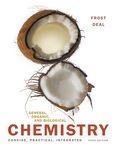
Concept explainers
a.
To determine:
If the reaction of nitrogen gas with hydrogen gas to form ammonia is a reversible or irreversible reaction.
Introduction:
The
b.
To determine:
If the reaction of methane and oxygen gas to form carbon dioxide and water is a reversible or irreversible reaction.
Introduction:
The chemical reaction is the process in which one or more reactant molecules react to form one or more products. Every chemical reaction is associated with a chemical change which is due to the difference in energy of reactants and products.
c.
To determine:
If the reaction of
Introduction:
The chemical reaction is the process in which one or more reactant molecules react to form one or more products. Every chemical reaction is associated with a chemical change which is due to the difference in energy of reactants and products.
Want to see the full answer?
Check out a sample textbook solution
Chapter 5 Solutions
EBK GENERAL, ORGANIC, AND BIOLOGICAL CH
- In which reaction is carbon reduced? A) CO(g) + ½ O₂(g) → CO₂(g) B) CO₂(g) + H₂O(l) → H₂CO₃(aq) C) CH₄(g) + 2O₂(g) → CO₂(g) + 2H₂O(l) D) C₂H₂(g) + H₂(g) → C₂H₄(g)arrow_forwardbipyridine)3]2* in its ground state and in an excited state. Compared to the ground state, the molecule in its excited state is a hv stronger oxidant and weaker reductant. stronger oxidant and stronger reductant. weaker oxidant and weaker reductant. weaker oxidant and stronger reductant.arrow_forwardIn each of the following three reaction coordinate diagrams, state: (a) Whether the reaction is exothermic or endothermic. (b) Whether the reaction is the slowest, the fastest, or intermediate in rate. (c) If all three reactions have the same entropy change between the reactant and product, which reaction has the largest favorable G0.arrow_forward
- When writing an equation, how is a reversible reaction distinguished from a nonreversible reaction?arrow_forwardWhich of the following is true of reduction reaction? It is the removal of electrons from an atom or molecule. They are also referred to as dehydrogenation reactions An example of which is the conversion of Pyruvic acid to Lactic acid There is a decrease in the potential energy of the atom or molecule Which cells in the body convert most of the remaining fructose and practically all of the galactose to glucose? Sertoli cells Erythrocytes Parietal cells Hepatocytes Which of the following substances can be considered as metabolic intermediates?* Water ATP Pyruvic acid Glucosearrow_forwardWhich of the following will increase the production of Oz in the following reversible reaction?arrow_forward
- (a) Select all of the correct statements about reaction rates from the choices below. The lower the rate of a reaction the longer it takes to reach completion.Reaction rates increase with increasing temperature.The slowest step in a reaction is called the rate-determining step.Catalysts increase reaction rates.The fastest step in a reaction is called the rate-determining step.As a reaction progresses its rate goes down.Reaction rates can show little change as masses of solid reactants increase.arrow_forwardConsider the reversible reaction shown below. What effect, if any, would each of the following stresses have on the position of equilibrium? CO(NH2)2 (l) + 2 HCl (g) ↔ 2 NH3 (g) + COCl2 (g) ; ∆H = -10.0 kJ/mol Addition of a suitable catalyst Addition of gaseous ammonia An increase in temperature Removing gaseous ammonia The system is compressed (increase total pressure) hints: give answers as directions or the favored side of the reactionarrow_forwardWhich would you predict to react at a faster rate when all other conditions are equal? Br2 gas Br2 liquidarrow_forward
- 2) The equilibrium constant Ke for the reaction A B is 1 x 105 at room temperature (25°C). a) You make a solution containing compound A at a concentration of 1 M and compound B at a concentration of 1 mM of B, and let the reaction proceed to equilibrium. What are the equilibrium concentrations of A and B? b) Calculate the standard free-energy change (AG) for this reaction. c) What is the standard free-energy change (AG) for the inverse reaction (BA)?arrow_forwardA thermodynamically-controlled process describes a reaction that, generates the most stable product O generates the product whose formation requires the smallest energy of activation O generates the product requiring the fewest steps O generates the product formed at the fastest rate O generates the product favored at low temperaturesarrow_forwardGiven this reaction at equilibrium, C(s) + CO2(g) D 2CO(g) (∆H° = 119kJ), explain the changes that would occur when the following stresses are applied or removed for this reaction. CO is removed. Heat is added. CO2 is added. Heat is removed.arrow_forward
 Living By Chemistry: First Edition TextbookChemistryISBN:9781559539418Author:Angelica StacyPublisher:MAC HIGHER
Living By Chemistry: First Edition TextbookChemistryISBN:9781559539418Author:Angelica StacyPublisher:MAC HIGHER Chemistry by OpenStax (2015-05-04)ChemistryISBN:9781938168390Author:Klaus Theopold, Richard H Langley, Paul Flowers, William R. Robinson, Mark BlaserPublisher:OpenStax
Chemistry by OpenStax (2015-05-04)ChemistryISBN:9781938168390Author:Klaus Theopold, Richard H Langley, Paul Flowers, William R. Robinson, Mark BlaserPublisher:OpenStax Introductory Chemistry: A FoundationChemistryISBN:9781337399425Author:Steven S. Zumdahl, Donald J. DeCostePublisher:Cengage Learning
Introductory Chemistry: A FoundationChemistryISBN:9781337399425Author:Steven S. Zumdahl, Donald J. DeCostePublisher:Cengage Learning- Chemistry: Matter and ChangeChemistryISBN:9780078746376Author:Dinah Zike, Laurel Dingrando, Nicholas Hainen, Cheryl WistromPublisher:Glencoe/McGraw-Hill School Pub Co

 Chemistry: An Atoms First ApproachChemistryISBN:9781305079243Author:Steven S. Zumdahl, Susan A. ZumdahlPublisher:Cengage Learning
Chemistry: An Atoms First ApproachChemistryISBN:9781305079243Author:Steven S. Zumdahl, Susan A. ZumdahlPublisher:Cengage Learning





